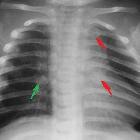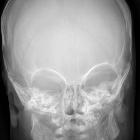physiologische Periostreaktion des Neugeborenen

Infant with
an unexplained death undergoing post-mortem imaging. AP radiograph of the lower extremities shows faint symmetrical periosteal reaction in the diaphyseal region of the tibas bilaterally.The diagnosis was physiologic periosteal reaction.
Physiologic periostitis describes the normal presence of smooth bilateral diaphyseal periosteal new bone in the humeri, femora or tibiae of infants aged 1 to 6 months. It can be observed in both preterm and term infants. The etiology is unclear but may simply relate to rapid growth.
Radiographic features
- long bones: tibiae, humeri, and femora relatively equally affected
- diaphyseal smooth periosteal reaction which may extend partly into the metaphyseal region, but not to the end of the metaphysis
- always bilateral and usually symmetric in extent
- organized and lamellar
- often concentric around the bone but may predominate on one aspect
- when tibial, it is always seen along the medial aspect
- no fracture or metaphyseal corner lucency
- no flat bone involvement
Nuclear medicine
Skeletal scintigraphy
Normal uptake is observed in contrast there is high uptake in trauma .
Differential diagnosis
- trauma/non-accidental injury
- not symmetric, lucent fracture line, soft-tissue swelling
- osteomyelitis
- not symmetric, usually metaphyseal, soft-tissue swelling
- Caffey disease (infantile cortical hyperostosis)
- same age group, flat bone involvement, soft-tissue swelling
Siehe auch:

 Assoziationen und Differentialdiagnosen zu physiologische Periostreaktion des Neugeborenen:
Assoziationen und Differentialdiagnosen zu physiologische Periostreaktion des Neugeborenen:


